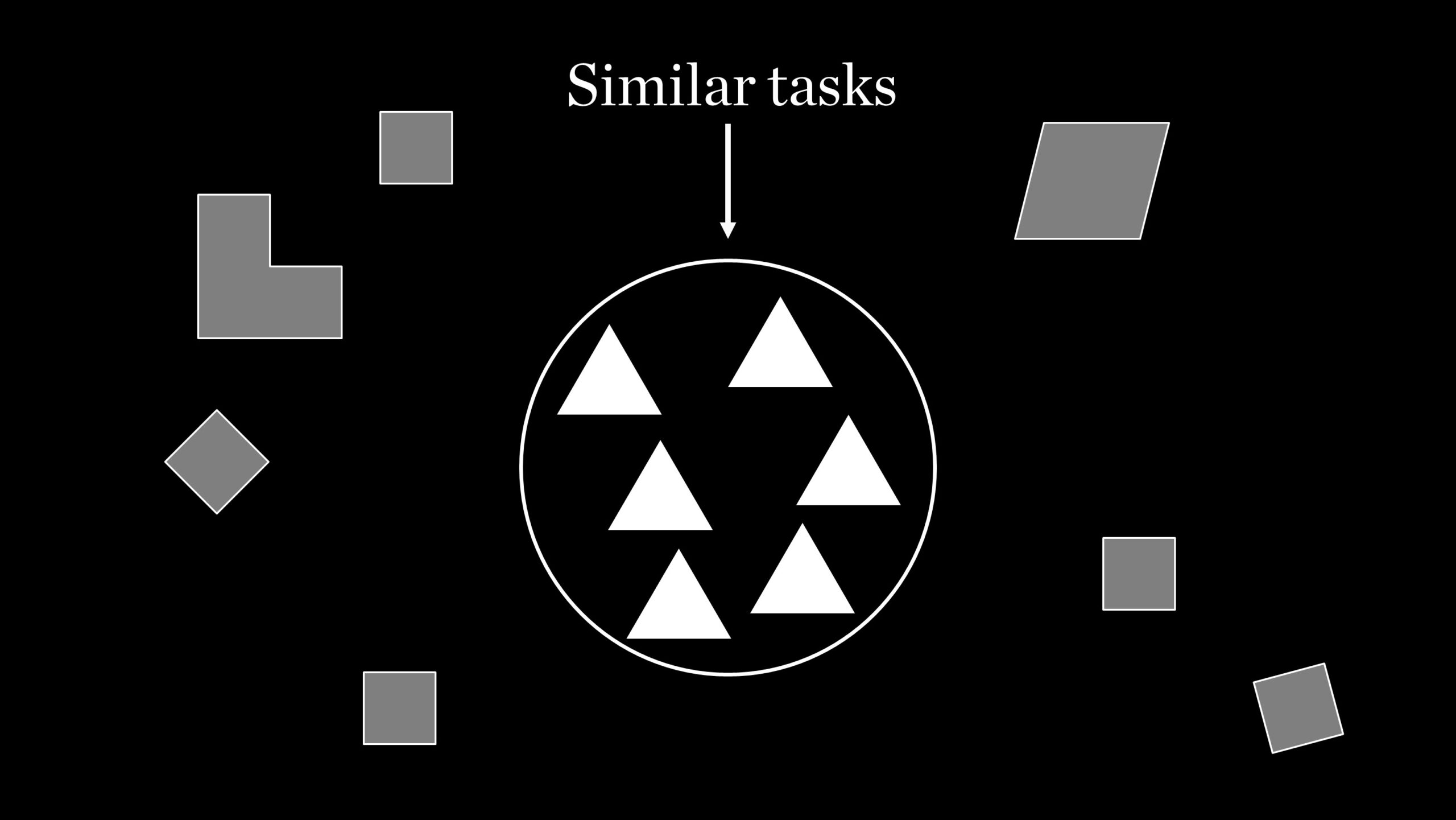Article last updated on November 19, 2023
Batch working is the practice of focusing on a single thing and completing all of the tasks associated with it.
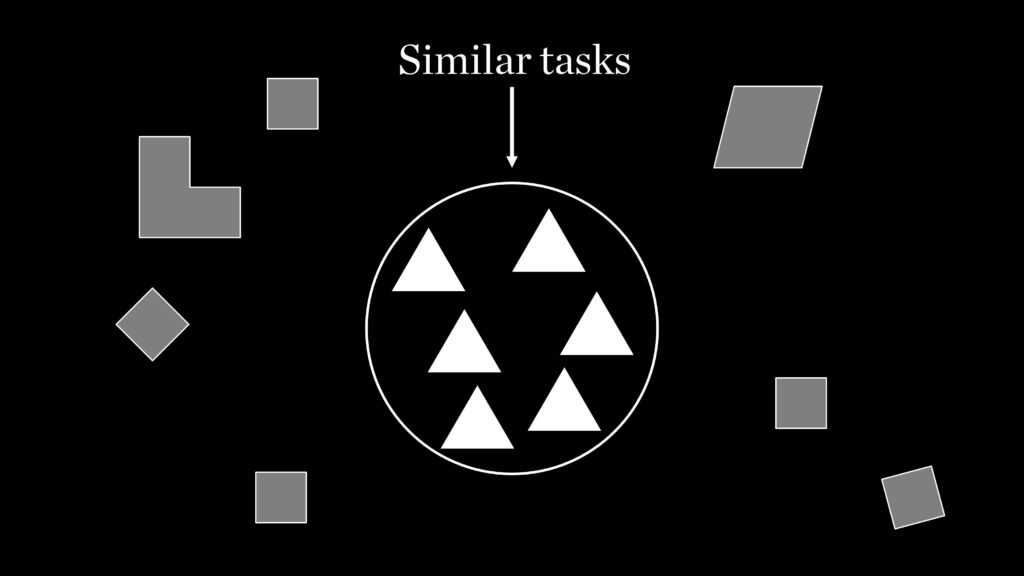
For example, today, my batch work consists of writing all day. Nothing else.
The next day, I’ll work on developing Clarity Blueprints for my clients.
Every day I’ve assigned myself a specific role and only tasks for that role.
This way, I can focus on one task at a time without getting distracted by other things.
I could do 100 different things, but if I’m not focused on anything, nothing will get done, and the quality of whatever gets done will be poor.
It’s not that you can’t do other things while doing your batch work, but if you produce poor quality stuff, guess what happens in the long term? You’re creating an unstable foundation for everything in your life.
So when we talk about batch working, we are talking about focusing on one thing at a time to produce high-quality results.
If you want to learn more about getting started with batch work, keep reading.
I’ve put together this article as a guide to help you understand what batch work is, why it’s essential, and how to start practicing it in your life right now.
I’m also going to give you some tips on making sure you don’t fall into any common mistakes that people make when they first try batch work.
Let’s jump right into it!
What Is Batch Working
As I’ve already mentioned, batch working is the act of bundling similar tasks together and focusing specifically working on them at a given moment in time.
You might think that this sounds like multitasking, which is NOT what we’re trying to achieve here.
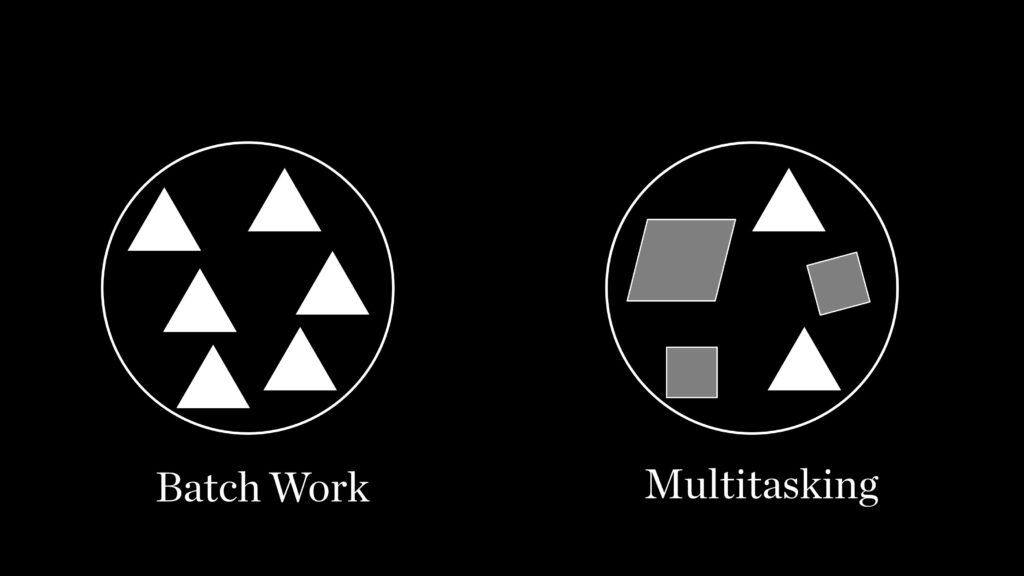
Multitasking means switching between multiple things at once, and this is a bad habit because it causes us to lose our concentration and focus.
We end up producing low-quality results or, worse yet, no results at all.
We have a singular focus with batch work, so there’s no need to switch back and forth from one task to another, and we just focus on one thing at once.
The more you practice batch work, the easier it becomes to stay focused on one thing at the moment in time.
To understand what batch working is, let me explain it to you using an accurate world analogy.
Imagine you were building a house.
You have a blueprint that shows you exactly where each piece of furniture needs to go.
Each room has its purpose.
Each room has a door to quickly access it from another part of the house.
Now imagine that you had many random pieces of furniture lying around everywhere.
You’d never know where anything was or how to use them because there’s no connection between them.
That would be like having many random ideas floating around in your head.
You might think you know what you need to do, but you just don’t learn how to connect those thoughts into action.
In reality, you don’t even know where to begin.
When you’re trying to build a house, you need to follow the blueprint.
You need to know where every piece of furniture goes before building the house.
But if you don’t have a blueprint, you’re just throwing random pieces together, hoping that eventually, it’ll turn out okay.
And that’s what most people do with their day-to-day tasks.
They throw random ideas together, hoping that somehow, someday, they’ll end up producing good results.
But the truth is, if you don’t know where to begin, then you won’t ever get anywhere.
And that’s why batch working is so important.
Because once you have a blueprint, you can start making progress towards whatever goal you have set for yourself.
Types Of Batch Work
There are endless ways to create some form of batch work, but I’ll focus on the four most important ones and sort them from most common to least common.
Daily batch work
If you are a solopreneur, the easiest way to start batch working is to assign yourself a role within your business.
For example, you could decide that you would be the content production person for one day.
Then the next day, you can become the social media manager.
Or maybe you want to be a salesperson for two straight days.
Whatever you choose, make sure that you stick to it.
If you decide to be a salesperson, you should keep doing that until you reach your goal.
If you decide to be the content producer, you should continue to be that until you’ve reached your goal.
This type of batch work helps you develop discipline and grit to stick to one thing.
It also allows you to see tangible results in a specific area as soon as possible.
An entire week could be divided into three different parts.
One chunk could be Monday through Wednesday.
Another chunk could be Thursday through Saturday.
And then the final chunk could be from Sunday through Tuesday.
By dividing your week this way, you can ensure that each chunk will contain at least one task that you can complete during that period.
So, instead of randomly assigning tasks throughout the week, you can now only do certain things on certain days.

Weekly batch work
Another great way is to start batch working by dividing your weeks into specific role-based weeks.
You can devote an entire week to marketing, another week to content creation, etc.
This method works best when you already have a clear idea of what you want to accomplish during that time frame.
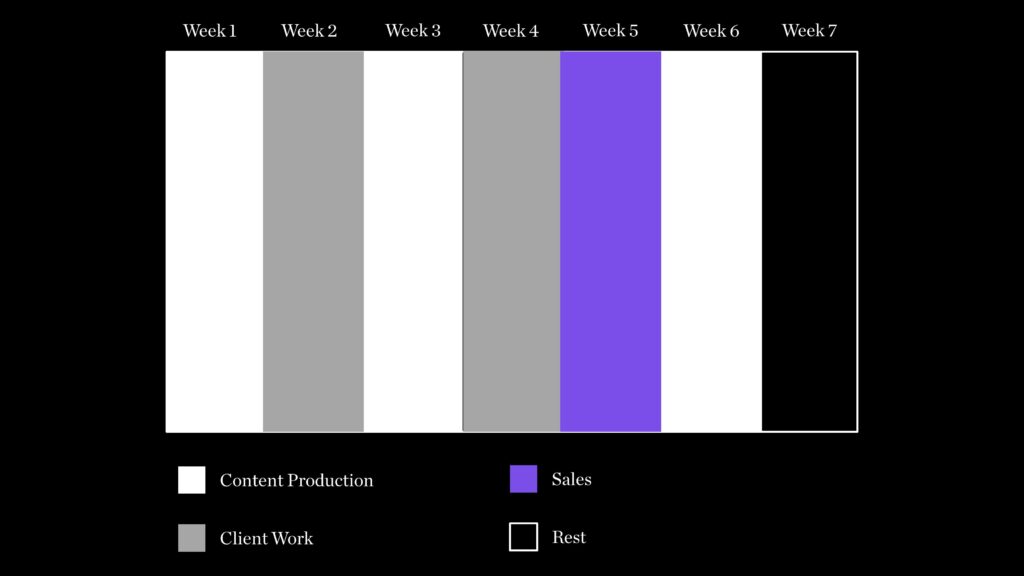
Monthly batch work
A third option is to divide your month into chunks based on months.
So, for example, you could allocate a whole month to content creation.

Hourly batch work
Finally, there’s hourly batch work.
This means that you’re focusing on one specific task per hour.
Hourly batch work is great if you want to overcome procrastination. You can check out all major causes of procrastination in this article.
Why Should You Practice Batch Working?
Well, first of all, it gives you more control over your life.
When you practice batch working, you no longer have to worry about whether or not you’re going to finish something.
That’s because you’ve already decided how long you’re going to spend on each task.
Plus, it gives you a sense of accomplishment when you finally complete something.
But the biggest reason why you should practice batch working is that it makes you more efficient.
Instead of spending hours trying to figure out which task to do first, you can just get started right away.
And since you know exactly what needs to be done, you won’t waste any time.
Who Should Batch Work?
Ideally, anyone who wants to improve their productivity should practice batch working.
Of course, you need to have an option to dictate how much time you want to allocate to each task.
The best roles for batch work include:
- Entrepreneurs
- Freelancers
- Programmers
- Designers
- Content creators
- Writers
- Marketers
- Project managers
- Photographers
- Students
There are other roles to which batch work applies too. But these are some of the most common ones.
Now we will talk about the most significant benefits of batch work, and believe me, there are many, but I’ll keep it straightforward.
Biggest Batch Work Benefits
The most prominent benefit, bar none, is that it improves your focus.
If you’re constantly switching from one task to another, you might end up doing nothing productive.
However, if you commit yourself to one single task for a given amount of time, you’ll be able to achieve more than ever before.
Batch working increases efficiency
One of the most significant advantages of batch working is its ability to help you become more efficient.
Once you decide how much time you’re willing to dedicate to a particular task, you’re free to focus solely on that task.
No distractions, no interruptions, no worries about finishing the job.
It’s like having a dedicated workspace where you can only focus on one thing at a time.
In fact, this is the main reason why people choose to work in coffee shops.
They don’t want to deal with distractions, so they go to places where they can focus without being bothered by others.
Batch working creates mental clarity
What is worse than having mental clutter that drains your mental energy?
You may find yourself struggling to think clearly because of all the stuff you have got to do.
On top of that, you may feel overwhelmed by all the things you still need to do.
To avoid this situation, you need to make sure that you’re always focused on one thing at a given time without lowering your energy levels.
Batch working eliminates the need for productivity hacks
Since you’re dedicating a certain amount of time to a specific task, you won’t need to resort to shortcuts to boost your productivity.
There are many ways to increase your output without actually getting anything done.
Tactics are great for boosting your productivity temporarily.
However, they won’t bring long-lasting results. That’s why you should try to eliminate the need for productivity hacks.
By eliminating the need for productivity hacks, you’ll be able to get rid of all those distracting apps, websites, tools, etc.
This means less distraction, less stress, less anxiety, less procrastination, and ultimately, more time for you to spend on what matters.
Batch working helps you build momentum
When you’re busy with multiple tasks at once, it’s easy to lose track of time.
As a result, you may not realize when you’ve been sitting idle for long enough.
But when you limit yourself to one task at a time, you’ll know exactly when you should stop working.
And since you’ll be focusing on just one thing, you’ll also be able to get more done in less time.
That means you’ll spend less time waiting around and more time accomplishing something.
Batch working makes you more organized
Another advantage of batch working is that it allows you to organize your projects into different categories.
So, instead of trying to juggle everything together, you can easily separate them into different folders or even subfolders.
This way, it will be easier to keep track of each project and its deadlines.
Batch working reduces stress
When you’re constantly switching between several tasks, it’s hard to maintain your concentration level.
However, when you’re limited to one task at a given time, you’ll be better equipped to handle any unexpected situations.
Plus, you’ll be able to enjoy the fruits of your labor without worrying about losing valuable time.
Batch working helps you recognize low-value tasks
If you’re constantly switching between multiple tasks, it becomes challenging to identify which ones are worth doing.
If you have too many tasks on your plate, you might end up wasting time on some of them.
The good news is that you don’t have to worry about that anymore.
You’ll only focus on tasks that matter to you with batch working.
You’ll be able to quickly determine whether or not these tasks are worthy of your attention.
And because you’ll only be working on high-priority tasks, you’ll be able to save your time for things that truly matter.
Batch working removes goal shifting
To be blunt on this one, people goal-shift because they are not 100% committed to a particular task.
They start by saying, “I’m going to work on X,” then “Oh, I’ll do Y first.” Then they say, “No, let me finish Z first,” and so on.
At the end of the day, they haven’t accomplished anything.
With batching tasks, you commit to a specific task until completion; goal shifting doesn’t happen.
How To Batch Work
Now that we’ve covered the benefits of batching, let’s talk about how to start doing it.
I will try to make this as simple as possible while still providing you with all the information you’ll need about this topic.
Identify Your Output
First off, you’ll need to figure out what kind of output you want from batching.
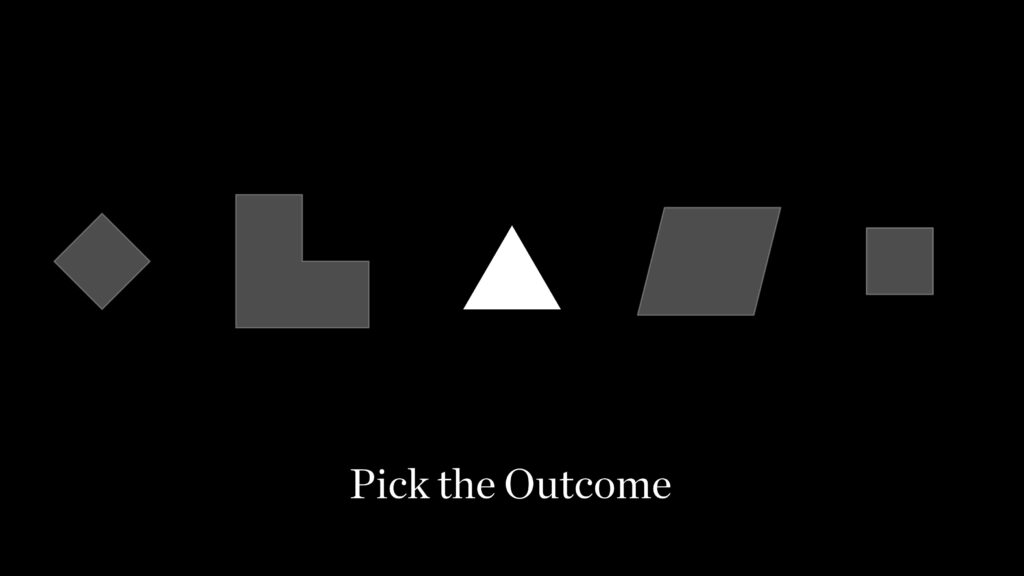
What is it? What is the end goal?
Let’s say that you want to grow your business’s net profit by 150%.
What do you need to do to achieve that?
Every business is different, but let’s say in this case, the best approach would be by:
- Reducing marketing ad spent
- Increasing organic traffic to the website
- Converting more leads into sales
- Have a better pricing structure model
- Create a 100% profit margin product as an upsell for existing customers
You need to think, what would have the most significant impact, and without it, nothing else would matter.
In this case, that would be to laser-focus on increasing organic traffic to the website.
Now it is your turn.
Pick your outcome.
Really think about this.
Don’t just guess.
If you need help with online business growth, I can help you with my growth plan, but I would highly encourage you to think this through.
Once this is done, we can move on to the next step.
Identify Your Processes
Look at the “mini” tasks that go into a process.

For example, if you want to increase organic traffic, you could break down the whole process like this:
- Create content
- Publish content
- Promote content
- Measure results
- Repeat steps 1-4
So now that you know what your processes look like, it will be obvious what takes the bulk of your time.
What takes the bulk of your time should be categorized.
For example, if creating videos is a complicated or exhausting thing to do, you can batch that process.
Make it a filming day.
Batch record 5 videos in a row.
If it’s editing, make it an editing day. Edit all 5 videos in a row.
If it’s writing, make it a writing day. Write 3 articles in a row.
You get the point.
It is easier to continue working when you are already in the zone.
When you identify these processes, you can easily decide which ones should be batch worked.
You’ll notice some friction points that might take you out of the flow as you are doing this.
This signals that you need to break the process into even smaller processes.
For example, when you record videos, you’ll probably need to have some kind of script or plan for what you’re going to talk about.
That means you need to batch work for the video script and then batch work on recording videos.
Without it, you’ll mindlessly go back and forth.
Make a schedule
One batch work activity takes more time than the other one.
And since you don’t want to lose momentum, you’ll want to set a schedule so that you won’t feel overwhelmed.

A pro-tip is to add buffer time between batching activities.
Say you write a script for 2 hours. Some days, it will take you longer, and others you will breeze through them, but at least your next batching activity will not be interrupted.
Stick to the process
The last thing you want to do is stop working because something went wrong.
It is easy to fall off track when trying to make things happen quickly.
But if you stick to the process, you’ll be able to stay focused and avoid distractions.
Common Pitfalls When Doing Batch Work
Here are some common pitfalls that people tend to fall into when they try to batch work their way to success.
Not setting goals
Setting goals is the key to any successful project. If you don’t set clear goals, you’ll never achieve them, and in fact, you’ll end up wasting time. Don’t let yourself drift away from your goal.
Set small milestones along the way.
If you don’t reach those milestones, adjust your goals and start again.
Not properly breaking down your work
Biting more than you can chew is a sure-fire way to fail.
Breaking down your work helps you stay organized, and you’ll also be able to see how much time each step takes.
When you have everything broken down, you’ll be able to set realistic deadlines.
If you are spending too much time on a single task, break it down further.
Maybe you can split it into two tasks instead.
Or maybe you can delegate it to someone else who can handle it better than you can.
Allowing distractions to dictate your actions
Distractions are inevitable. But if you allow them to control your workflow, you’ll never achieve anything.
To avoid getting distracted, block certain websites, apps, social media accounts, etc.
Batching work is a fantastic way to block distractions, but even then, there’s always something that comes up.
So, as long as you aren’t allowing distractions to dictate your actions, you’ll be fine.
Mixing different types of tasks together
You should only mix similar tasks.
For example, if you are writing a blog post, you shouldn’t also be editing photos.
Instead, you should focus on one thing at a time. This is especially true if you are new to this type of work.
Working in isolation is the best way to get started.
Once you gain experience, you’ll know what works well for you.
Overworking
This happens when you push yourself too hard. Larger tasks require more time.
As such, you need to pace yourself. Don’t go crazy and overwork yourself.
If you feel like you will burn out, take a break.
Then come back and pick up where you left off.
Working on shallow tasks
This is the primary problem with not correctly identifying the main outcome, and as a consequence, you could fall into the trap of doing shallow, non-essential tasks.
You might think that these tasks are essential, but they’re really not.
They may seem important now, but they won’t matter later.
Final outcomes are what matters. So make sure that all the tasks you undertake are necessary.
FAQ About Batching Work
Here are some frequently asked questions about batching work.
How long does a typical day of batch work last?
A typical day of batch work lasts anywhere between 2 hours and 4 hours.
Keep in mind that this is for a typical day. As mentioned at the beginning of the post, you can batch an entire week or even an entire month for a specific activity.
What kind of tasks are typical for batch work?
The most common tasks are:
Writing articles, creating content, editing images, sending emails.
These are the core activities that will help you build your business. However, there are other things that you can do too.
For example, you can write blog posts, create videos, or simply answer customer support inquiries. Each of these activities has its own unique benefits.
How can I improve planning for batch work?
You can use tools such as Trello boards, Google Sheets, Notion, Evernote, etc.
Whatever method you choose, just make sure you have an organized plan.
Otherwise, you’ll end up wasting lots of time trying to figure out what needs to be done next.
Is batch work good for me?
Yes! If you want to grow a profitable online business, batch work is the perfect solution, and it allows you to focus on what matters the most. And it helps you achieve your goals faster than ever before.
How do I know if I am batching work correctly?
There are three key indicators that you are doing batch work correctly. First, you should be able to identify the primary goal of your project.
Second, you should be able to complete multiple smaller projects within a single timeframe. Finally, you should be able to achieve those goals without feeling overwhelmed.
In addition, you should also be able to measure your progress towards achieving those goals.
Are there any downsides to batch work?
Batch work comes with its own set of challenges, and one challenge is that you may find it hard to stay focused on one thing.
Another challenge is that you may get bored quickly. So keep in mind that you must always have something to look forward to.
What is an example of when I should not batch my work?
If you are working on a task requiring a lot of research, it’s best to avoid batch work.
Instead, try to spend more time researching. Remember that research takes time. You don’t need to rush through it.
Also, if you are working on a project requiring a lot of creativity, it’s best to avoid batch work altogether. This is because creativity doesn’t lend itself well to batching.
If you are unsure whether a particular task is creative or not, ask yourself the following question:
Does this task require me to think outside the box?
If so, then it’s probably a creative task.
If not, then it’s probably not a creative task.
What tools can help me when I batch work?
As mentioned earlier, there are many different methods and tools that you can use.
Here are some examples:
Trello
Google Sheets
Google Calendar
Notion
Evernote
Asana
Personally, I use Notion to organize my output, aka what I want to achieve, and then Google Calendar to block time for batch work.
Summary
All in all, batch work is a great way to increase productivity because it allows you to focus on what really matters and complete tasks quickly.
In short, you just need to follow this simple process:
- Identify your output. What is it? What is your end goal? Think about what would have the biggest effect on your business.
- Identify your processes. See what takes up most of your time. Processes that take too much time should be broken down into smaller ones.
- Schedule your batch work. It allows you to plan and complete work at the right time.
- Buffer time between batching activities. You never know precisely how long each activity will take, so make sure you give yourself enough buffer time.
- Measure your results. Make sure you’re measuring your success by tracking your progress. This will allow you to see which areas you need to improve upon.
- Sticking to the process helps you avoid distractions. Remember that batch work is meant to help you accomplish things faster. If you feel like you’re getting distracted, it means that you’re doing something wrong.
So, remember these steps when you start batching your work.


